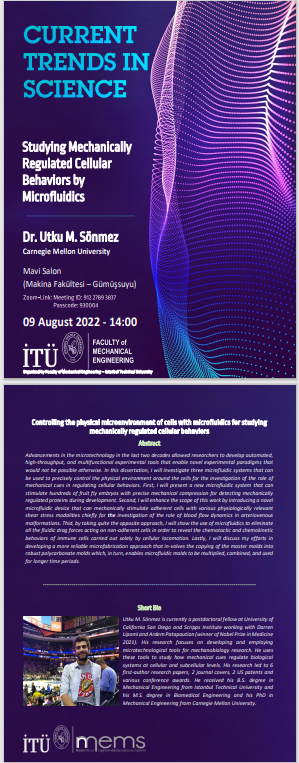Controlling the physical microenvironment of cells with microfluidics for studying mechanically regulated cellular behaviors
Abstract
Advancements in the microtechnology in the last two decades allowed researchers to develop automated, high-throughput, and multifunctional experimental tools that enable novel experimental paradigms that would not be possible otherwise. In this dissertation, I will investigate three microfluidic systems that can be used to precisely control the physical environment around the cells for the investigation of the role of mechanical cues in regulating cellular behaviors. First, I will present a new microfluidic system that can stimulate hundreds of fruit fly embryos with precise mechanical compression for detecting mechanically regulated proteins during development. Second, I will enhance the scope of this work by introducing a novel microfluidic device that can mechanically stimulate adherent cells with various physiologically relevant shear stress modalities chiefly for the investigation of the role of blood flow dynamics in arteriovenous malformations. Thid, by taking quite the opposite approach, I will show the use of microfluidics to eliminate all the fluidic drag forces acting on non-adherent cells in order to reveal the chemotactic and chemokinetic behaviors of immune cells carried out solely by cellular locomotion. Lastly, I will discuss my efforts in developing a more reliable microfabrication approach that in-volves the copying of the master molds into robust polycarbonate molds which, in turn, enables microfluidic molds to be multiplied, combined, and used for longer time periods.
Short Bio
Utku M. Sönmez is currently a postdoctoral fellow at University of California San Diego and Scripps Institute working with Darren Lipomi and Ardem Patapoutian (winner of Nobel Prize in Medicine 2021). His research focuses on developing and employing microtechnological tools for mechanobiology research. He uses these tools to study how mechanical cues regulate biological systems at cellular and subcellular levels. His research led to 6 first-author research papers, 2 journal covers, 2 US patents and various conference awards. He received his B.S. degree in Mechanical Engineering from Istanbul Technical University and his M.S. degree in Biomedical Engineering and his PhD in Mechanical Engineering from Carnegie Mellon University.
